Prostate Cancer: A Comprehensive Report on Public Health Implications
VerifiedAdded on 2021/01/03
|13
|3158
|25
Report
AI Summary
This report addresses prostate cancer as a significant public health issue in the UK, examining its prevalence, definitions from various health organizations (WHO, NHS, and Prostate Cancer UK), and statistical data on diagnosis and mortality. It delves into the availability of primary, secondary, tertiary, and primordial interventions, including health promotion, specific protection measures like screening, and treatment options such as surgery, radiation therapy, and chemotherapy. The report also discusses public health interventions at both individual and community levels, emphasizing the role of healthcare professionals in disease prevention and control. The report provides a comprehensive overview of the disease and the strategies available to combat it.

HEALTH INEQUALITIES
TABLE OF CONTENTS
TABLE OF CONTENTS
Paraphrase This Document
Need a fresh take? Get an instant paraphrase of this document with our AI Paraphraser

INTRODUCTION...........................................................................................................................1
MAIN BODY..................................................................................................................................1
Public Health Issue......................................................................................................................1
Official Definition of Prostate Cancer from World Health Organisation (WHO)......................3
Official Definition of Prostate Cancer from NHS.......................................................................3
Official Definition of Prostate Cancer from charity....................................................................4
Availability of Primary interventions..........................................................................................4
Availability of Secondary interventions......................................................................................5
Availability of Tertiary interventions..........................................................................................6
Primordial intervention availability for this issue.......................................................................7
Public Health Intervention available for this issue at both, an Individual and community level 8
Role as a Healthcare professional in preventing and controlling the spread of disease..............9
CONCLUSION..............................................................................................................................10
REFERENCES..............................................................................................................................11
MAIN BODY..................................................................................................................................1
Public Health Issue......................................................................................................................1
Official Definition of Prostate Cancer from World Health Organisation (WHO)......................3
Official Definition of Prostate Cancer from NHS.......................................................................3
Official Definition of Prostate Cancer from charity....................................................................4
Availability of Primary interventions..........................................................................................4
Availability of Secondary interventions......................................................................................5
Availability of Tertiary interventions..........................................................................................6
Primordial intervention availability for this issue.......................................................................7
Public Health Intervention available for this issue at both, an Individual and community level 8
Role as a Healthcare professional in preventing and controlling the spread of disease..............9
CONCLUSION..............................................................................................................................10
REFERENCES..............................................................................................................................11

INTRODUCTION
This assignment is purely based on one of the public health issues of UK and its related
implications on the society as the whole. Prostate Cancer has been considered here.
MAIN BODY
Public Health Issue Prostate Cancer is becoming a menace and has been refereed as the third biggest cancer
killer in UK (Cockerell, 2018). As per statistics, one man dies from prostate cancer in
every 45 minutes in England.
Prostate is a male gland found near the bladder’s neck, that releases a fluid in order to
protect and sustain sperm. This is located beneath the bladder and supports urethra so that
men can easily urinate or ejaculate through.
As per survey, there has been studies that one out of 8 get affected by this cancer. This
occurs to the population who are mostly elderly men with age over 60 years and black
men as well.
It is majorly diagnosed between the age of 65 to 69, however men below 50 can get it too
but is uncommon.
Out of four black men, one is more prone to prostate cancer at a specific point due to
genes or unhealthy lifestyle.
It is that type where there is a possibility of carrying the faulty genes, if somebody’s
family member had it in their past or can be passed within a family from 1 generation to
the next.as it is interconnected biological scheming of genes.
The following tabular column provides the following statistics on the basis of segregation
of geographical regions:
Areas England Scotland Wales Northern
Ireland
No. of
Diagnosis
cases (every
year)
Around 40000
men
More than 3000
men
More than
2500 men
More than 1000
men
1
This assignment is purely based on one of the public health issues of UK and its related
implications on the society as the whole. Prostate Cancer has been considered here.
MAIN BODY
Public Health Issue Prostate Cancer is becoming a menace and has been refereed as the third biggest cancer
killer in UK (Cockerell, 2018). As per statistics, one man dies from prostate cancer in
every 45 minutes in England.
Prostate is a male gland found near the bladder’s neck, that releases a fluid in order to
protect and sustain sperm. This is located beneath the bladder and supports urethra so that
men can easily urinate or ejaculate through.
As per survey, there has been studies that one out of 8 get affected by this cancer. This
occurs to the population who are mostly elderly men with age over 60 years and black
men as well.
It is majorly diagnosed between the age of 65 to 69, however men below 50 can get it too
but is uncommon.
Out of four black men, one is more prone to prostate cancer at a specific point due to
genes or unhealthy lifestyle.
It is that type where there is a possibility of carrying the faulty genes, if somebody’s
family member had it in their past or can be passed within a family from 1 generation to
the next.as it is interconnected biological scheming of genes.
The following tabular column provides the following statistics on the basis of segregation
of geographical regions:
Areas England Scotland Wales Northern
Ireland
No. of
Diagnosis
cases (every
year)
Around 40000
men
More than 3000
men
More than
2500 men
More than 1000
men
1
⊘ This is a preview!⊘
Do you want full access?
Subscribe today to unlock all pages.

Trusted by 1+ million students worldwide
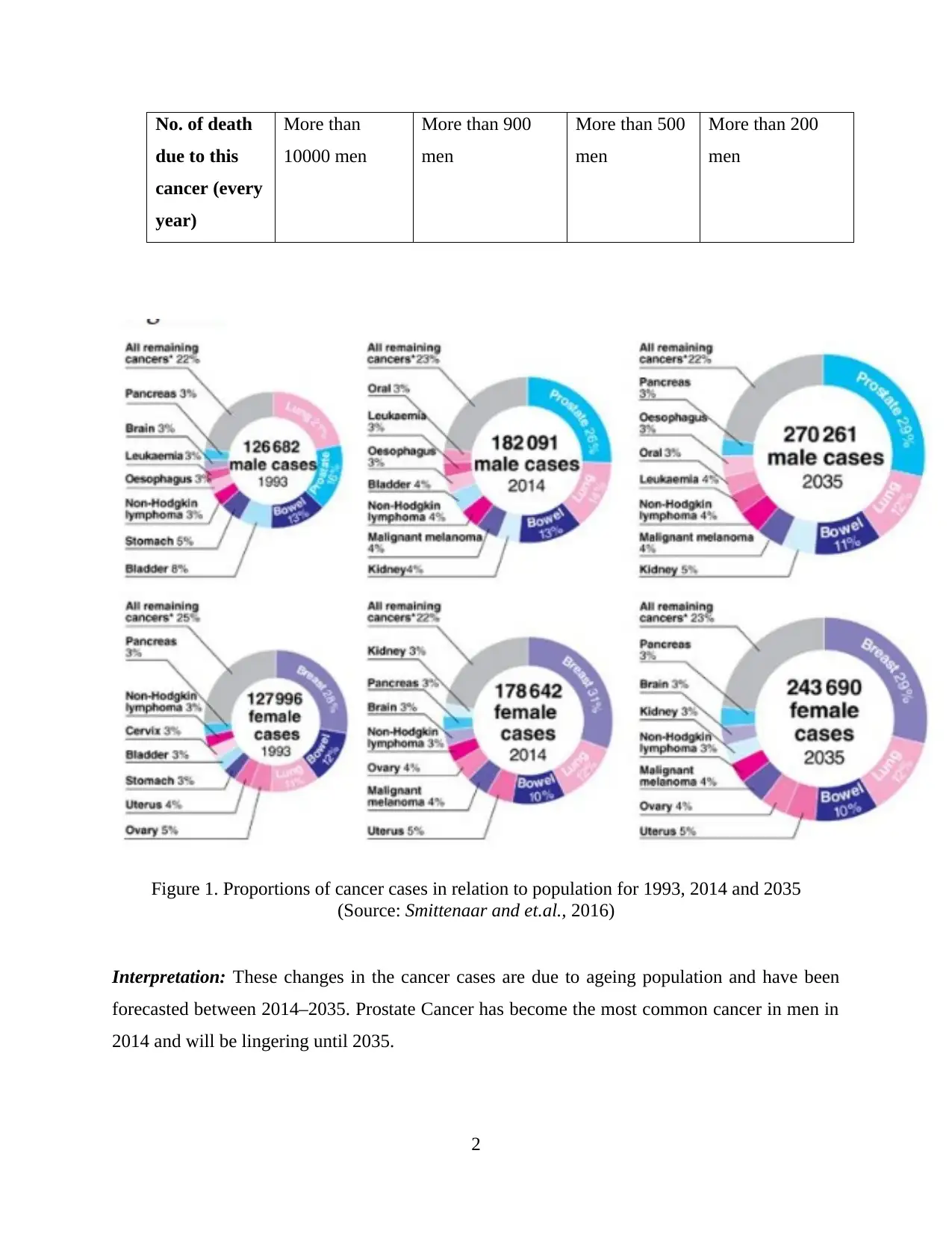
No. of death
due to this
cancer (every
year)
More than
10000 men
More than 900
men
More than 500
men
More than 200
men
Figure 1. Proportions of cancer cases in relation to population for 1993, 2014 and 2035
(Source: Smittenaar and et.al., 2016)
Interpretation: These changes in the cancer cases are due to ageing population and have been
forecasted between 2014–2035. Prostate Cancer has become the most common cancer in men in
2014 and will be lingering until 2035.
2
due to this
cancer (every
year)
More than
10000 men
More than 900
men
More than 500
men
More than 200
men
Figure 1. Proportions of cancer cases in relation to population for 1993, 2014 and 2035
(Source: Smittenaar and et.al., 2016)
Interpretation: These changes in the cancer cases are due to ageing population and have been
forecasted between 2014–2035. Prostate Cancer has become the most common cancer in men in
2014 and will be lingering until 2035.
2
Paraphrase This Document
Need a fresh take? Get an instant paraphrase of this document with our AI Paraphraser
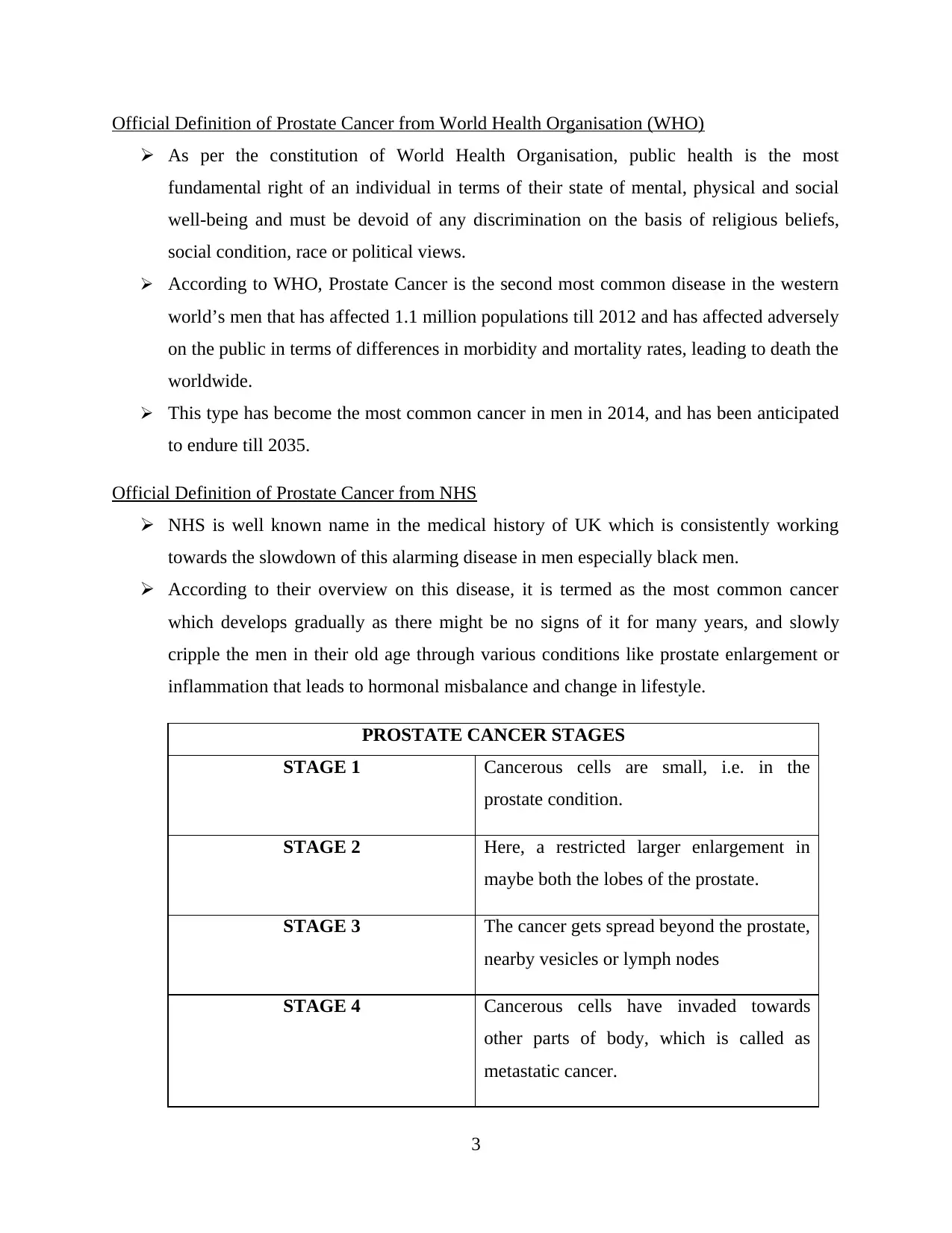
Official Definition of Prostate Cancer from World Health Organisation (WHO)
As per the constitution of World Health Organisation, public health is the most
fundamental right of an individual in terms of their state of mental, physical and social
well-being and must be devoid of any discrimination on the basis of religious beliefs,
social condition, race or political views.
According to WHO, Prostate Cancer is the second most common disease in the western
world’s men that has affected 1.1 million populations till 2012 and has affected adversely
on the public in terms of differences in morbidity and mortality rates, leading to death the
worldwide.
This type has become the most common cancer in men in 2014, and has been anticipated
to endure till 2035.
Official Definition of Prostate Cancer from NHS
NHS is well known name in the medical history of UK which is consistently working
towards the slowdown of this alarming disease in men especially black men.
According to their overview on this disease, it is termed as the most common cancer
which develops gradually as there might be no signs of it for many years, and slowly
cripple the men in their old age through various conditions like prostate enlargement or
inflammation that leads to hormonal misbalance and change in lifestyle.
PROSTATE CANCER STAGES
STAGE 1 Cancerous cells are small, i.e. in the
prostate condition.
STAGE 2 Here, a restricted larger enlargement in
maybe both the lobes of the prostate.
STAGE 3 The cancer gets spread beyond the prostate,
nearby vesicles or lymph nodes
STAGE 4 Cancerous cells have invaded towards
other parts of body, which is called as
metastatic cancer.
3
As per the constitution of World Health Organisation, public health is the most
fundamental right of an individual in terms of their state of mental, physical and social
well-being and must be devoid of any discrimination on the basis of religious beliefs,
social condition, race or political views.
According to WHO, Prostate Cancer is the second most common disease in the western
world’s men that has affected 1.1 million populations till 2012 and has affected adversely
on the public in terms of differences in morbidity and mortality rates, leading to death the
worldwide.
This type has become the most common cancer in men in 2014, and has been anticipated
to endure till 2035.
Official Definition of Prostate Cancer from NHS
NHS is well known name in the medical history of UK which is consistently working
towards the slowdown of this alarming disease in men especially black men.
According to their overview on this disease, it is termed as the most common cancer
which develops gradually as there might be no signs of it for many years, and slowly
cripple the men in their old age through various conditions like prostate enlargement or
inflammation that leads to hormonal misbalance and change in lifestyle.
PROSTATE CANCER STAGES
STAGE 1 Cancerous cells are small, i.e. in the
prostate condition.
STAGE 2 Here, a restricted larger enlargement in
maybe both the lobes of the prostate.
STAGE 3 The cancer gets spread beyond the prostate,
nearby vesicles or lymph nodes
STAGE 4 Cancerous cells have invaded towards
other parts of body, which is called as
metastatic cancer.
3
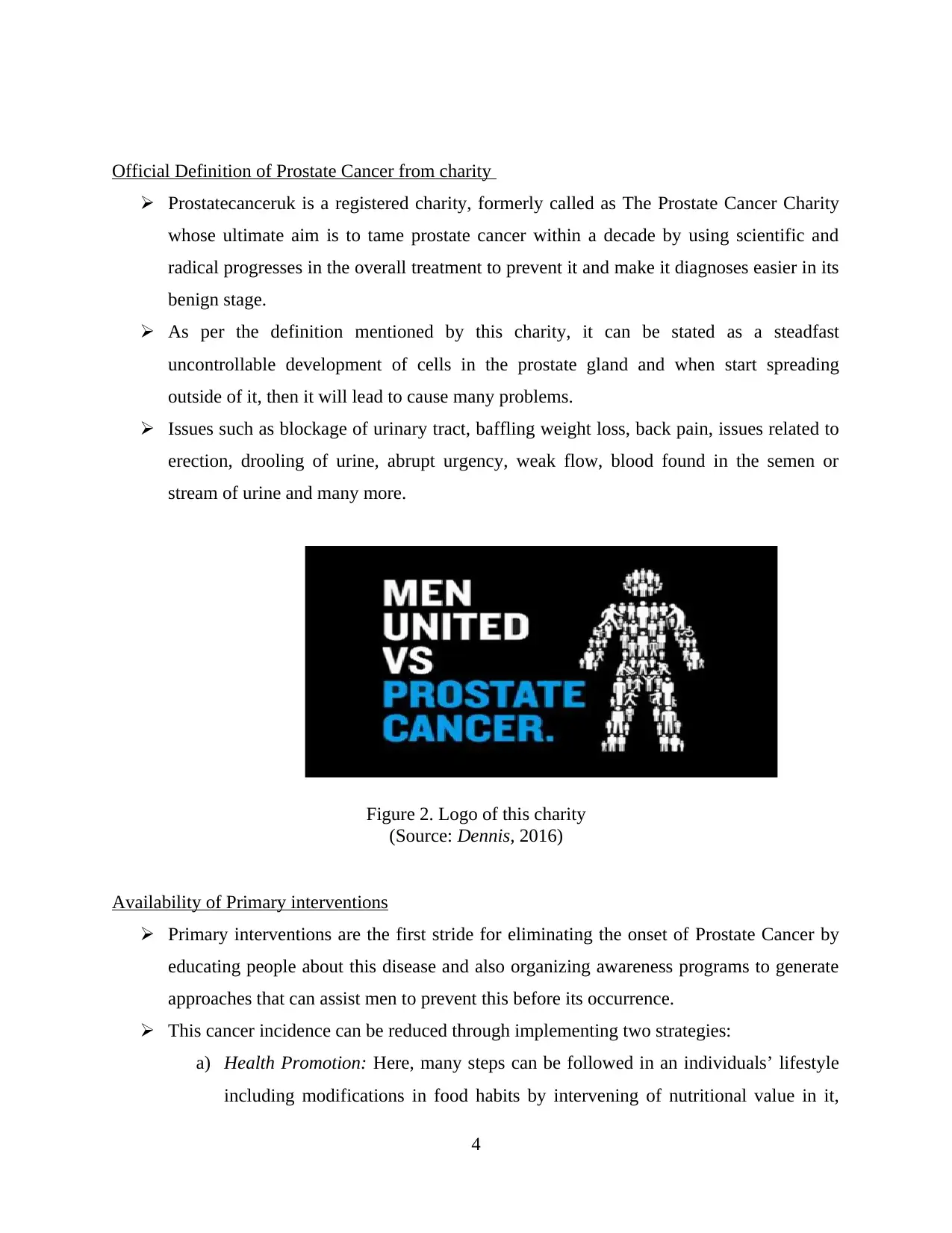
Official Definition of Prostate Cancer from charity
Prostatecanceruk is a registered charity, formerly called as The Prostate Cancer Charity
whose ultimate aim is to tame prostate cancer within a decade by using scientific and
radical progresses in the overall treatment to prevent it and make it diagnoses easier in its
benign stage.
As per the definition mentioned by this charity, it can be stated as a steadfast
uncontrollable development of cells in the prostate gland and when start spreading
outside of it, then it will lead to cause many problems.
Issues such as blockage of urinary tract, baffling weight loss, back pain, issues related to
erection, drooling of urine, abrupt urgency, weak flow, blood found in the semen or
stream of urine and many more.
Figure 2. Logo of this charity
(Source: Dennis, 2016)
Availability of Primary interventions
Primary interventions are the first stride for eliminating the onset of Prostate Cancer by
educating people about this disease and also organizing awareness programs to generate
approaches that can assist men to prevent this before its occurrence.
This cancer incidence can be reduced through implementing two strategies:
a) Health Promotion: Here, many steps can be followed in an individuals’ lifestyle
including modifications in food habits by intervening of nutritional value in it,
4
Prostatecanceruk is a registered charity, formerly called as The Prostate Cancer Charity
whose ultimate aim is to tame prostate cancer within a decade by using scientific and
radical progresses in the overall treatment to prevent it and make it diagnoses easier in its
benign stage.
As per the definition mentioned by this charity, it can be stated as a steadfast
uncontrollable development of cells in the prostate gland and when start spreading
outside of it, then it will lead to cause many problems.
Issues such as blockage of urinary tract, baffling weight loss, back pain, issues related to
erection, drooling of urine, abrupt urgency, weak flow, blood found in the semen or
stream of urine and many more.
Figure 2. Logo of this charity
(Source: Dennis, 2016)
Availability of Primary interventions
Primary interventions are the first stride for eliminating the onset of Prostate Cancer by
educating people about this disease and also organizing awareness programs to generate
approaches that can assist men to prevent this before its occurrence.
This cancer incidence can be reduced through implementing two strategies:
a) Health Promotion: Here, many steps can be followed in an individuals’ lifestyle
including modifications in food habits by intervening of nutritional value in it,
4
⊘ This is a preview!⊘
Do you want full access?
Subscribe today to unlock all pages.

Trusted by 1+ million students worldwide
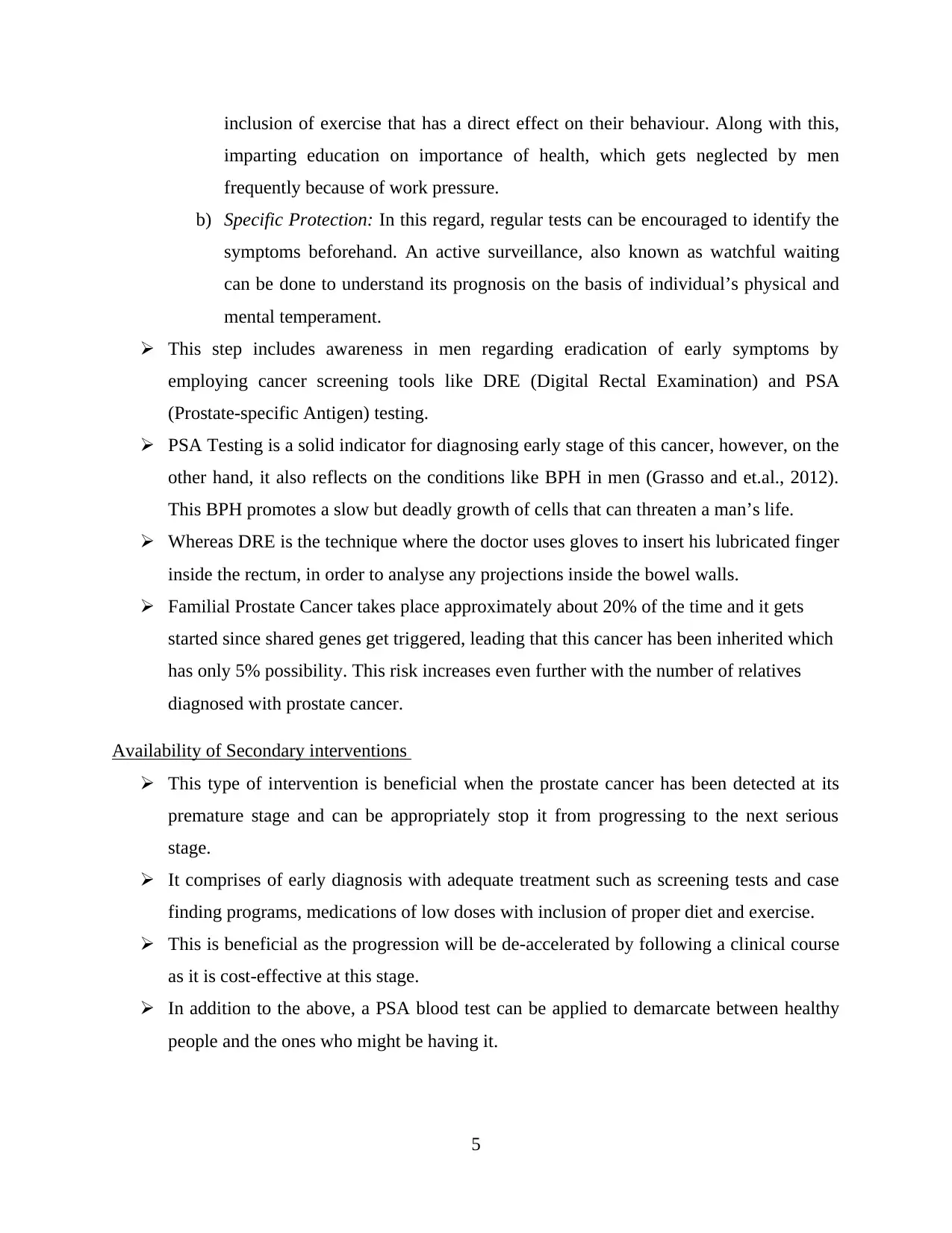
inclusion of exercise that has a direct effect on their behaviour. Along with this,
imparting education on importance of health, which gets neglected by men
frequently because of work pressure.
b) Specific Protection: In this regard, regular tests can be encouraged to identify the
symptoms beforehand. An active surveillance, also known as watchful waiting
can be done to understand its prognosis on the basis of individual’s physical and
mental temperament.
This step includes awareness in men regarding eradication of early symptoms by
employing cancer screening tools like DRE (Digital Rectal Examination) and PSA
(Prostate-specific Antigen) testing.
PSA Testing is a solid indicator for diagnosing early stage of this cancer, however, on the
other hand, it also reflects on the conditions like BPH in men (Grasso and et.al., 2012).
This BPH promotes a slow but deadly growth of cells that can threaten a man’s life.
Whereas DRE is the technique where the doctor uses gloves to insert his lubricated finger
inside the rectum, in order to analyse any projections inside the bowel walls.
Familial Prostate Cancer takes place approximately about 20% of the time and it gets
started since shared genes get triggered, leading that this cancer has been inherited which
has only 5% possibility. This risk increases even further with the number of relatives
diagnosed with prostate cancer.
Availability of Secondary interventions
This type of intervention is beneficial when the prostate cancer has been detected at its
premature stage and can be appropriately stop it from progressing to the next serious
stage.
It comprises of early diagnosis with adequate treatment such as screening tests and case
finding programs, medications of low doses with inclusion of proper diet and exercise.
This is beneficial as the progression will be de-accelerated by following a clinical course
as it is cost-effective at this stage.
In addition to the above, a PSA blood test can be applied to demarcate between healthy
people and the ones who might be having it.
5
imparting education on importance of health, which gets neglected by men
frequently because of work pressure.
b) Specific Protection: In this regard, regular tests can be encouraged to identify the
symptoms beforehand. An active surveillance, also known as watchful waiting
can be done to understand its prognosis on the basis of individual’s physical and
mental temperament.
This step includes awareness in men regarding eradication of early symptoms by
employing cancer screening tools like DRE (Digital Rectal Examination) and PSA
(Prostate-specific Antigen) testing.
PSA Testing is a solid indicator for diagnosing early stage of this cancer, however, on the
other hand, it also reflects on the conditions like BPH in men (Grasso and et.al., 2012).
This BPH promotes a slow but deadly growth of cells that can threaten a man’s life.
Whereas DRE is the technique where the doctor uses gloves to insert his lubricated finger
inside the rectum, in order to analyse any projections inside the bowel walls.
Familial Prostate Cancer takes place approximately about 20% of the time and it gets
started since shared genes get triggered, leading that this cancer has been inherited which
has only 5% possibility. This risk increases even further with the number of relatives
diagnosed with prostate cancer.
Availability of Secondary interventions
This type of intervention is beneficial when the prostate cancer has been detected at its
premature stage and can be appropriately stop it from progressing to the next serious
stage.
It comprises of early diagnosis with adequate treatment such as screening tests and case
finding programs, medications of low doses with inclusion of proper diet and exercise.
This is beneficial as the progression will be de-accelerated by following a clinical course
as it is cost-effective at this stage.
In addition to the above, a PSA blood test can be applied to demarcate between healthy
people and the ones who might be having it.
5
Paraphrase This Document
Need a fresh take? Get an instant paraphrase of this document with our AI Paraphraser

Here, when men have PSA level of ≥4.0 ng/ml, then it must be referred for DRE, trans
rectal ultrasound, and biopsy, while on the other hand, men with a 3.0–3.9 ng/ml of PSA
level must be presented with DRE only.
Subsequently, instructing the affected people with respect to this treatment procedure
including about the detection of the signs or symptoms, having a list of the health centres
for sessions, type of treatment to pursue or including medication as per doctor’s
recommendations.
Assigning of Brachytheraphy or internal radiation therapy can be promoted as the
cancerous cells would be located within the gland only.
This methodology determined by the implantation of seeds, which are small and
radioactive for over a period of few months depending upon the intensity of growth of
undesirable cells (Heidenreich and et.al., 2011). However, it gets injected inside the gland
but needs proper observations, thus leading the patient to stay in the hospital for few
hours before discharge.
Use of Vitamin D so that it can stop the cancer to further encroachments that can turned
to its hormone refractory.
Availability of Tertiary interventions
It is defined as the rehabilitation part where extreme measurements must be included to
provide therapy and recovery of patients by making the individual accustomed to the
impaired conditions.
A cyclic sequential order of screening, diagnosis, follow-up and interventions will be
identified and established for recuperating of diseased man by prostate cancer.
The coalition of medical interpretations with the vocational educational teachings by
combining with the societal cooperation would provide the promising outcomes
estimated for the affected patient.
This stage contains number of local treatment methods that has an effective impact on the
path towards recovery.
Surgery is one of the most common methods which has an oncologist doctor along with a
urologist, who assist in moving the affected prostate part with few healthy tissues (Bill-
Axelson and et.al., 2011). It does have side-effects like risk of losing sexual functionality
or damaging nerves related to erections or orgasm and urinary incontinence.
6
rectal ultrasound, and biopsy, while on the other hand, men with a 3.0–3.9 ng/ml of PSA
level must be presented with DRE only.
Subsequently, instructing the affected people with respect to this treatment procedure
including about the detection of the signs or symptoms, having a list of the health centres
for sessions, type of treatment to pursue or including medication as per doctor’s
recommendations.
Assigning of Brachytheraphy or internal radiation therapy can be promoted as the
cancerous cells would be located within the gland only.
This methodology determined by the implantation of seeds, which are small and
radioactive for over a period of few months depending upon the intensity of growth of
undesirable cells (Heidenreich and et.al., 2011). However, it gets injected inside the gland
but needs proper observations, thus leading the patient to stay in the hospital for few
hours before discharge.
Use of Vitamin D so that it can stop the cancer to further encroachments that can turned
to its hormone refractory.
Availability of Tertiary interventions
It is defined as the rehabilitation part where extreme measurements must be included to
provide therapy and recovery of patients by making the individual accustomed to the
impaired conditions.
A cyclic sequential order of screening, diagnosis, follow-up and interventions will be
identified and established for recuperating of diseased man by prostate cancer.
The coalition of medical interpretations with the vocational educational teachings by
combining with the societal cooperation would provide the promising outcomes
estimated for the affected patient.
This stage contains number of local treatment methods that has an effective impact on the
path towards recovery.
Surgery is one of the most common methods which has an oncologist doctor along with a
urologist, who assist in moving the affected prostate part with few healthy tissues (Bill-
Axelson and et.al., 2011). It does have side-effects like risk of losing sexual functionality
or damaging nerves related to erections or orgasm and urinary incontinence.
6
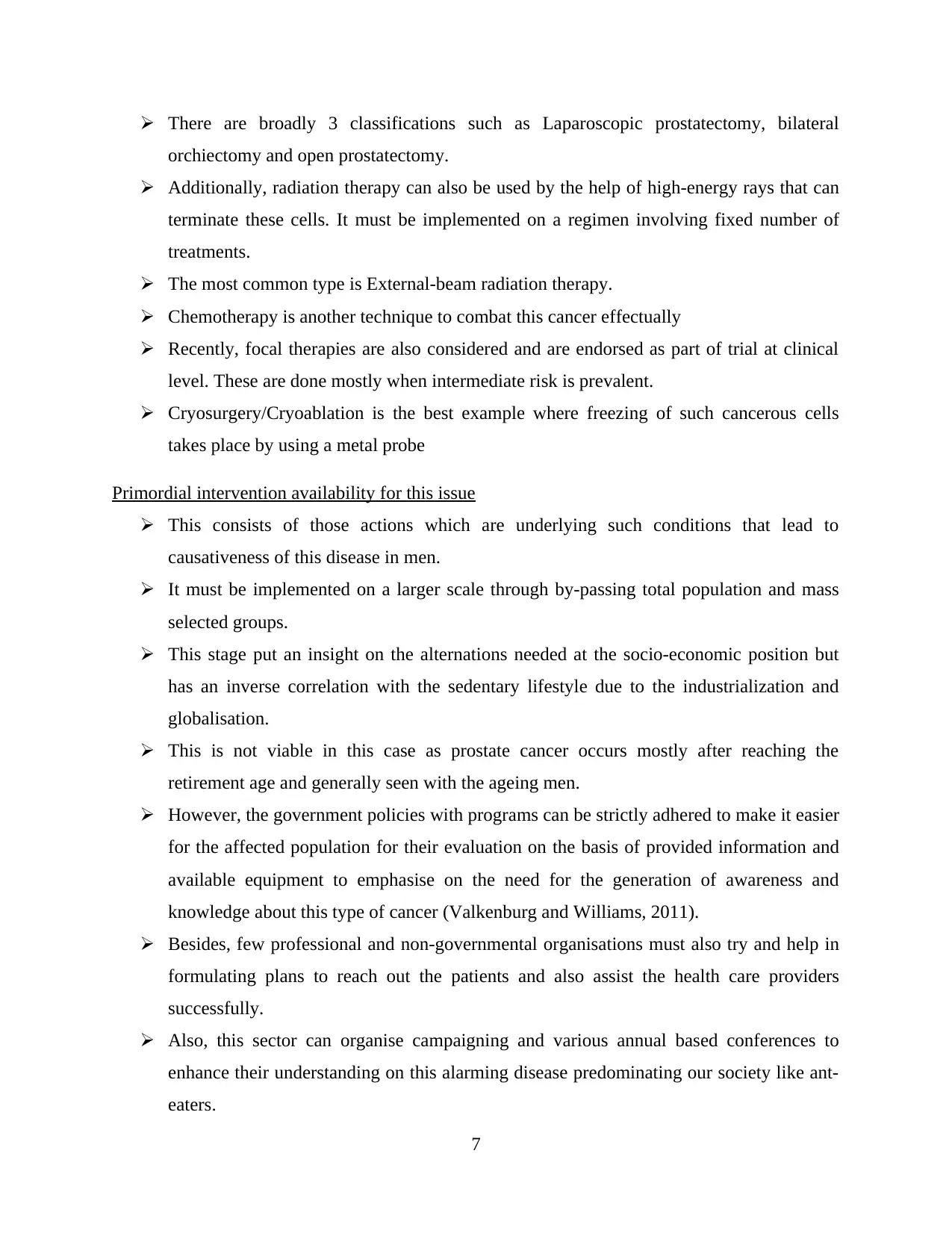
There are broadly 3 classifications such as Laparoscopic prostatectomy, bilateral
orchiectomy and open prostatectomy.
Additionally, radiation therapy can also be used by the help of high-energy rays that can
terminate these cells. It must be implemented on a regimen involving fixed number of
treatments.
The most common type is External-beam radiation therapy.
Chemotherapy is another technique to combat this cancer effectually
Recently, focal therapies are also considered and are endorsed as part of trial at clinical
level. These are done mostly when intermediate risk is prevalent.
Cryosurgery/Cryoablation is the best example where freezing of such cancerous cells
takes place by using a metal probe
Primordial intervention availability for this issue
This consists of those actions which are underlying such conditions that lead to
causativeness of this disease in men.
It must be implemented on a larger scale through by-passing total population and mass
selected groups.
This stage put an insight on the alternations needed at the socio-economic position but
has an inverse correlation with the sedentary lifestyle due to the industrialization and
globalisation.
This is not viable in this case as prostate cancer occurs mostly after reaching the
retirement age and generally seen with the ageing men.
However, the government policies with programs can be strictly adhered to make it easier
for the affected population for their evaluation on the basis of provided information and
available equipment to emphasise on the need for the generation of awareness and
knowledge about this type of cancer (Valkenburg and Williams, 2011).
Besides, few professional and non-governmental organisations must also try and help in
formulating plans to reach out the patients and also assist the health care providers
successfully.
Also, this sector can organise campaigning and various annual based conferences to
enhance their understanding on this alarming disease predominating our society like ant-
eaters.
7
orchiectomy and open prostatectomy.
Additionally, radiation therapy can also be used by the help of high-energy rays that can
terminate these cells. It must be implemented on a regimen involving fixed number of
treatments.
The most common type is External-beam radiation therapy.
Chemotherapy is another technique to combat this cancer effectually
Recently, focal therapies are also considered and are endorsed as part of trial at clinical
level. These are done mostly when intermediate risk is prevalent.
Cryosurgery/Cryoablation is the best example where freezing of such cancerous cells
takes place by using a metal probe
Primordial intervention availability for this issue
This consists of those actions which are underlying such conditions that lead to
causativeness of this disease in men.
It must be implemented on a larger scale through by-passing total population and mass
selected groups.
This stage put an insight on the alternations needed at the socio-economic position but
has an inverse correlation with the sedentary lifestyle due to the industrialization and
globalisation.
This is not viable in this case as prostate cancer occurs mostly after reaching the
retirement age and generally seen with the ageing men.
However, the government policies with programs can be strictly adhered to make it easier
for the affected population for their evaluation on the basis of provided information and
available equipment to emphasise on the need for the generation of awareness and
knowledge about this type of cancer (Valkenburg and Williams, 2011).
Besides, few professional and non-governmental organisations must also try and help in
formulating plans to reach out the patients and also assist the health care providers
successfully.
Also, this sector can organise campaigning and various annual based conferences to
enhance their understanding on this alarming disease predominating our society like ant-
eaters.
7
⊘ This is a preview!⊘
Do you want full access?
Subscribe today to unlock all pages.

Trusted by 1+ million students worldwide
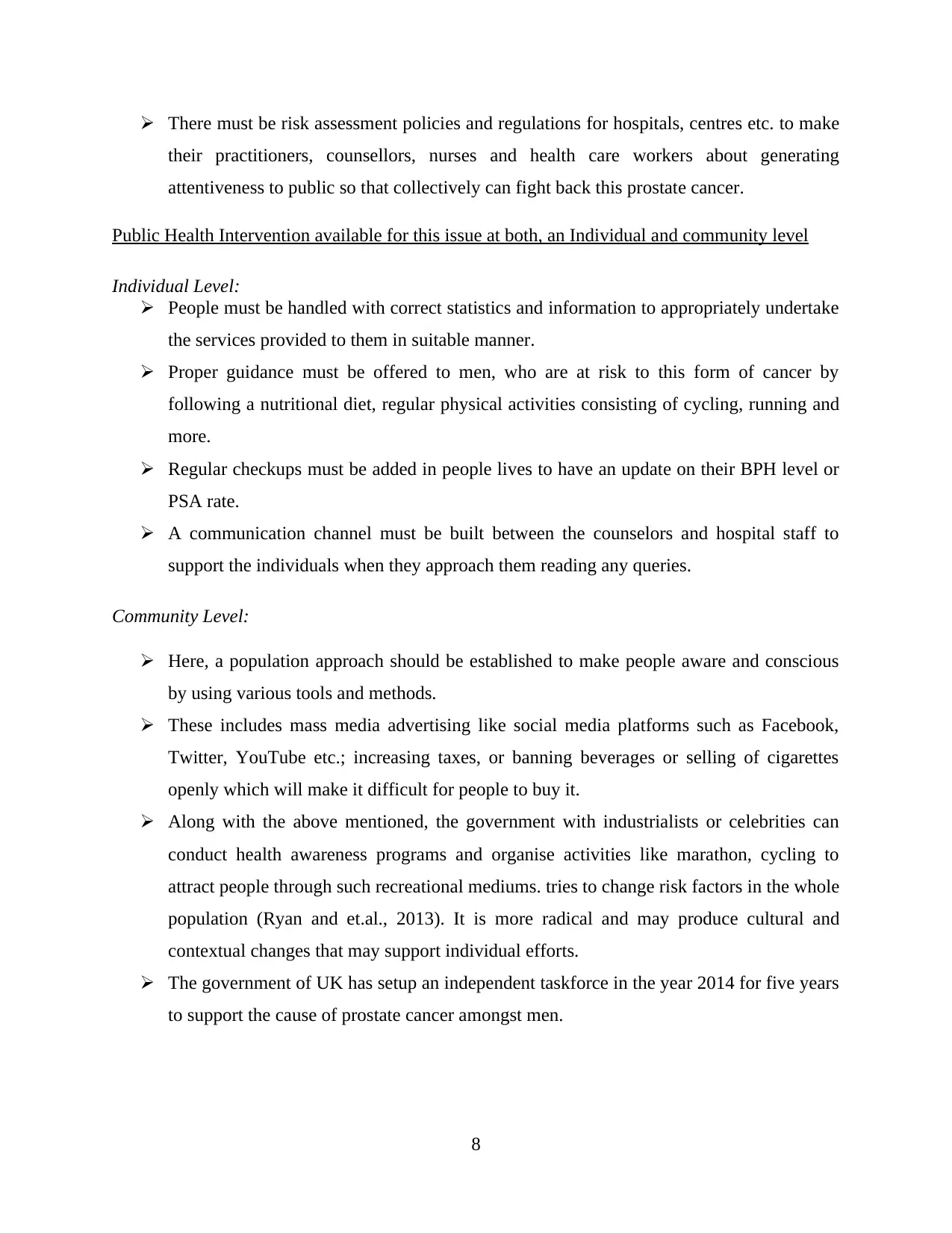
There must be risk assessment policies and regulations for hospitals, centres etc. to make
their practitioners, counsellors, nurses and health care workers about generating
attentiveness to public so that collectively can fight back this prostate cancer.
Public Health Intervention available for this issue at both, an Individual and community level
Individual Level:
People must be handled with correct statistics and information to appropriately undertake
the services provided to them in suitable manner.
Proper guidance must be offered to men, who are at risk to this form of cancer by
following a nutritional diet, regular physical activities consisting of cycling, running and
more.
Regular checkups must be added in people lives to have an update on their BPH level or
PSA rate.
A communication channel must be built between the counselors and hospital staff to
support the individuals when they approach them reading any queries.
Community Level:
Here, a population approach should be established to make people aware and conscious
by using various tools and methods.
These includes mass media advertising like social media platforms such as Facebook,
Twitter, YouTube etc.; increasing taxes, or banning beverages or selling of cigarettes
openly which will make it difficult for people to buy it.
Along with the above mentioned, the government with industrialists or celebrities can
conduct health awareness programs and organise activities like marathon, cycling to
attract people through such recreational mediums. tries to change risk factors in the whole
population (Ryan and et.al., 2013). It is more radical and may produce cultural and
contextual changes that may support individual efforts.
The government of UK has setup an independent taskforce in the year 2014 for five years
to support the cause of prostate cancer amongst men.
8
their practitioners, counsellors, nurses and health care workers about generating
attentiveness to public so that collectively can fight back this prostate cancer.
Public Health Intervention available for this issue at both, an Individual and community level
Individual Level:
People must be handled with correct statistics and information to appropriately undertake
the services provided to them in suitable manner.
Proper guidance must be offered to men, who are at risk to this form of cancer by
following a nutritional diet, regular physical activities consisting of cycling, running and
more.
Regular checkups must be added in people lives to have an update on their BPH level or
PSA rate.
A communication channel must be built between the counselors and hospital staff to
support the individuals when they approach them reading any queries.
Community Level:
Here, a population approach should be established to make people aware and conscious
by using various tools and methods.
These includes mass media advertising like social media platforms such as Facebook,
Twitter, YouTube etc.; increasing taxes, or banning beverages or selling of cigarettes
openly which will make it difficult for people to buy it.
Along with the above mentioned, the government with industrialists or celebrities can
conduct health awareness programs and organise activities like marathon, cycling to
attract people through such recreational mediums. tries to change risk factors in the whole
population (Ryan and et.al., 2013). It is more radical and may produce cultural and
contextual changes that may support individual efforts.
The government of UK has setup an independent taskforce in the year 2014 for five years
to support the cause of prostate cancer amongst men.
8
Paraphrase This Document
Need a fresh take? Get an instant paraphrase of this document with our AI Paraphraser

Moreover, they also grant a 300 million pounds so that the medical sector can be able to
install new equipment for diagnosis, hire new staff and also can offer packs with context
to post-recovery support to the patients.
Role as a Healthcare professional in preventing and controlling the spread of disease
Health sector has a pivotal role in spreading awareness and gaining attention as well.
They are able to pioneer new inventions or discoveries in the field of cancer.
As a health care professional, one can interact and communicate impartially with the
patients about the disease effectively.
They can organise meeting to indulge the entire staff in providing care, support and
cooperation to such patients.
The Diagnostic Pathway has assisted the health care providers along with the
professionals to provide with the latest practises, methodologies and equipment.
During the treatment duration, they can make the patient comfortable by providing them
with all the minute details regarding the practice to be used for their recovery.
Sometimes, the patient’s behaviour faces complications and unmanaged reaction
alternations due to the on-going process of the treatment and at such time, these
professionals must act wisely by giving them apt suggestions to ease their stress.
Campaigning or promotional activities regarding prostate cancer must be completed by
inculcating a sense of responsibility through demonstrating the details using flowcharts or
tables.
Funding through various sources like grants, commissions, donations etc. can lay a
foundation of right funding to make sustainable developments by the use of precision
medicine along with a proper screening tool so that it can boost the awareness amongst
men to take up the pre-initials tests.
Charities has contributed to 120 million pounds on the research so that the 10-year goal
of reducing the number of prostate cases can be minimised.
For example, a well-known celebrity from Big Brother fame, Wayne Sleep was
diagnosed with prostate cancer in the year 2015, who will be leading the London March
for Men for the second year running.
9
install new equipment for diagnosis, hire new staff and also can offer packs with context
to post-recovery support to the patients.
Role as a Healthcare professional in preventing and controlling the spread of disease
Health sector has a pivotal role in spreading awareness and gaining attention as well.
They are able to pioneer new inventions or discoveries in the field of cancer.
As a health care professional, one can interact and communicate impartially with the
patients about the disease effectively.
They can organise meeting to indulge the entire staff in providing care, support and
cooperation to such patients.
The Diagnostic Pathway has assisted the health care providers along with the
professionals to provide with the latest practises, methodologies and equipment.
During the treatment duration, they can make the patient comfortable by providing them
with all the minute details regarding the practice to be used for their recovery.
Sometimes, the patient’s behaviour faces complications and unmanaged reaction
alternations due to the on-going process of the treatment and at such time, these
professionals must act wisely by giving them apt suggestions to ease their stress.
Campaigning or promotional activities regarding prostate cancer must be completed by
inculcating a sense of responsibility through demonstrating the details using flowcharts or
tables.
Funding through various sources like grants, commissions, donations etc. can lay a
foundation of right funding to make sustainable developments by the use of precision
medicine along with a proper screening tool so that it can boost the awareness amongst
men to take up the pre-initials tests.
Charities has contributed to 120 million pounds on the research so that the 10-year goal
of reducing the number of prostate cases can be minimised.
For example, a well-known celebrity from Big Brother fame, Wayne Sleep was
diagnosed with prostate cancer in the year 2015, who will be leading the London March
for Men for the second year running.
9
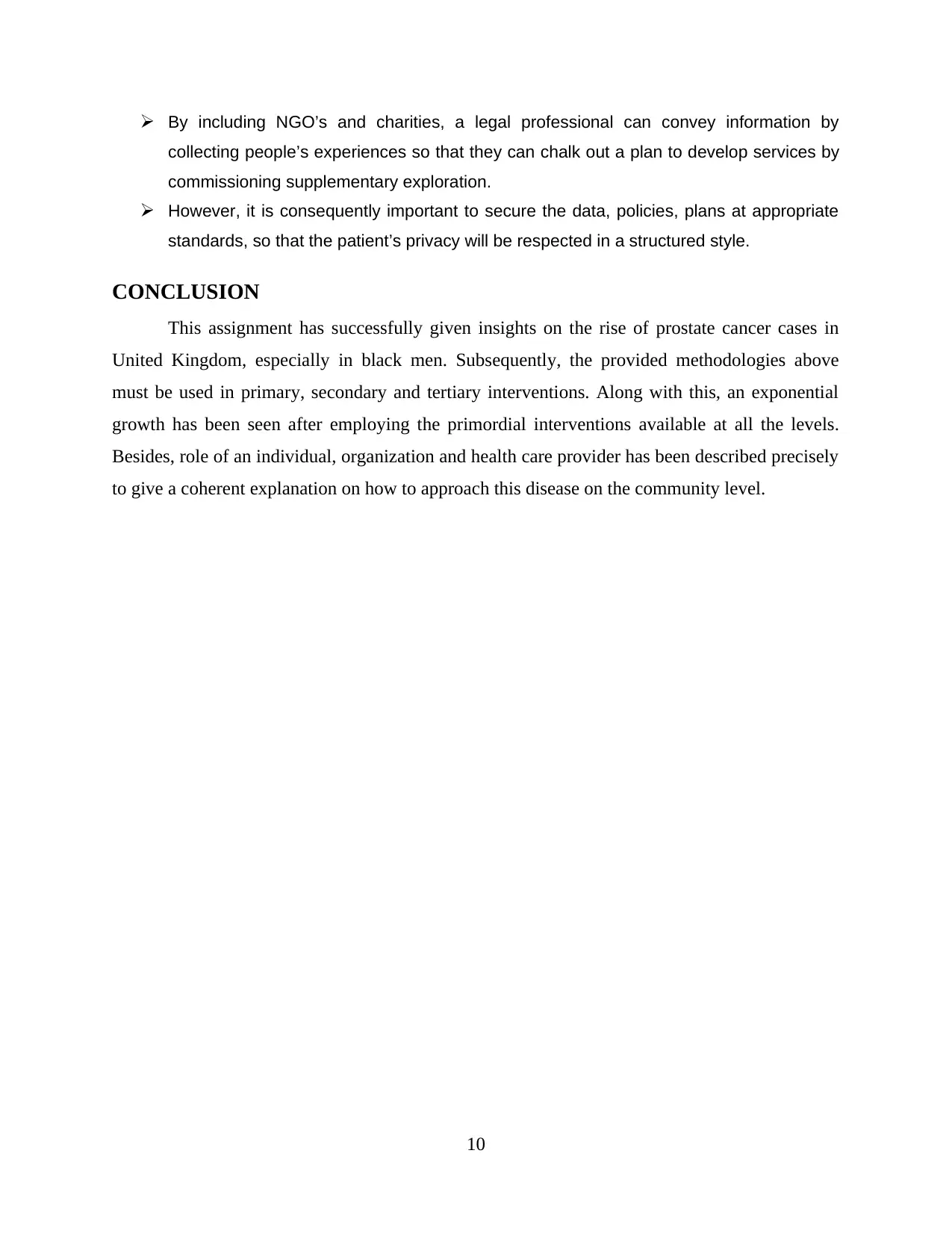
By including NGO’s and charities, a legal professional can convey information by
collecting people’s experiences so that they can chalk out a plan to develop services by
commissioning supplementary exploration.
However, it is consequently important to secure the data, policies, plans at appropriate
standards, so that the patient’s privacy will be respected in a structured style.
CONCLUSION
This assignment has successfully given insights on the rise of prostate cancer cases in
United Kingdom, especially in black men. Subsequently, the provided methodologies above
must be used in primary, secondary and tertiary interventions. Along with this, an exponential
growth has been seen after employing the primordial interventions available at all the levels.
Besides, role of an individual, organization and health care provider has been described precisely
to give a coherent explanation on how to approach this disease on the community level.
10
collecting people’s experiences so that they can chalk out a plan to develop services by
commissioning supplementary exploration.
However, it is consequently important to secure the data, policies, plans at appropriate
standards, so that the patient’s privacy will be respected in a structured style.
CONCLUSION
This assignment has successfully given insights on the rise of prostate cancer cases in
United Kingdom, especially in black men. Subsequently, the provided methodologies above
must be used in primary, secondary and tertiary interventions. Along with this, an exponential
growth has been seen after employing the primordial interventions available at all the levels.
Besides, role of an individual, organization and health care provider has been described precisely
to give a coherent explanation on how to approach this disease on the community level.
10
⊘ This is a preview!⊘
Do you want full access?
Subscribe today to unlock all pages.

Trusted by 1+ million students worldwide
1 out of 13
Related Documents
Your All-in-One AI-Powered Toolkit for Academic Success.
+13062052269
info@desklib.com
Available 24*7 on WhatsApp / Email
![[object Object]](/_next/static/media/star-bottom.7253800d.svg)
Unlock your academic potential
Copyright © 2020–2025 A2Z Services. All Rights Reserved. Developed and managed by ZUCOL.





